Comprehensive Report: Managing Workforce Engagement and Commitment
VerifiedAdded on 2020/02/05
|12
|3553
|64
Report
AI Summary
This report delves into the critical aspects of managing workforce engagement and commitment within organizations. It begins by exploring the unitary and pluralistic perspectives on employee relations, highlighting their impact on decision-making, conflict resolution, and overall organizational effectiveness. The report then examines the key ingredients of effective collective bargaining arrangements, including agreements, remuneration, and employment conditions, emphasizing the role of negotiation and mutual recognition of goals. Finally, it analyzes contemporary attempts to promote effective employee relations, such as partnerships, employee engagement initiatives, and employee voice mechanisms, assessing their merits and demerits. The report provides valuable insights into how organizations can foster a positive work environment, increase employee participation, and ultimately achieve their strategic objectives by prioritizing employee relations.
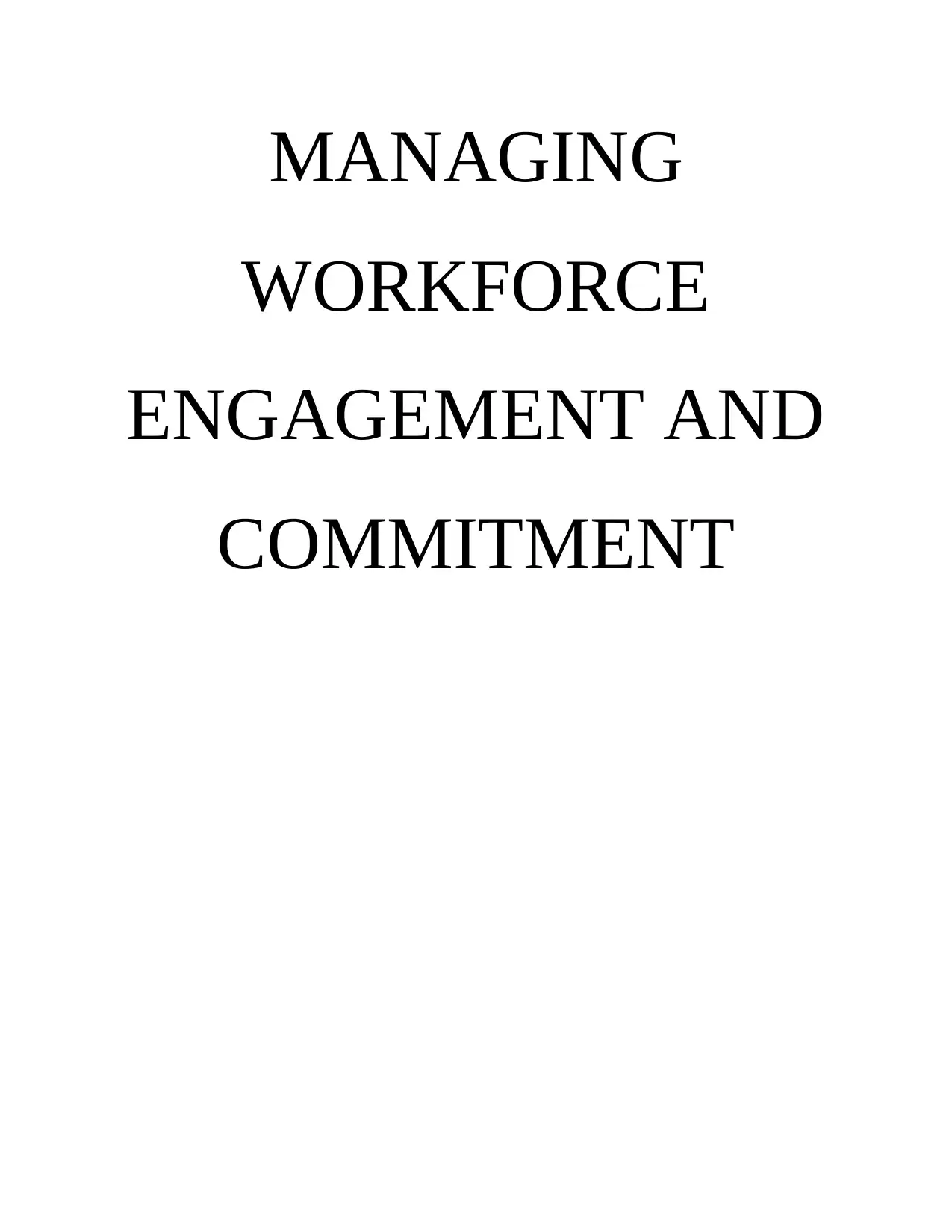
MANAGING
WORKFORCE
ENGAGEMENT AND
COMMITMENT
WORKFORCE
ENGAGEMENT AND
COMMITMENT
Paraphrase This Document
Need a fresh take? Get an instant paraphrase of this document with our AI Paraphraser
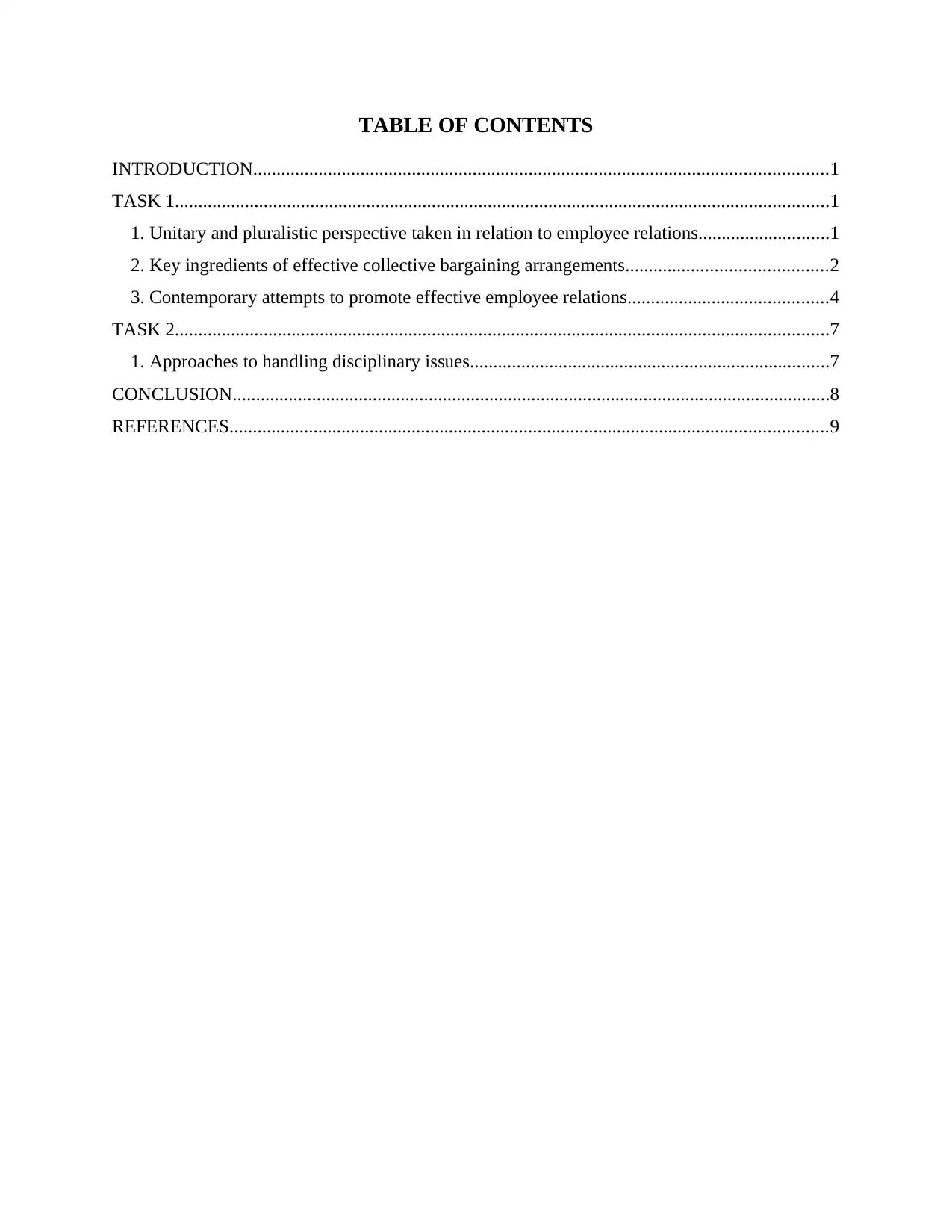
TABLE OF CONTENTS
INTRODUCTION...........................................................................................................................1
TASK 1............................................................................................................................................1
1. Unitary and pluralistic perspective taken in relation to employee relations............................1
2. Key ingredients of effective collective bargaining arrangements...........................................2
3. Contemporary attempts to promote effective employee relations...........................................4
TASK 2............................................................................................................................................7
1. Approaches to handling disciplinary issues.............................................................................7
CONCLUSION................................................................................................................................8
REFERENCES................................................................................................................................9
INTRODUCTION...........................................................................................................................1
TASK 1............................................................................................................................................1
1. Unitary and pluralistic perspective taken in relation to employee relations............................1
2. Key ingredients of effective collective bargaining arrangements...........................................2
3. Contemporary attempts to promote effective employee relations...........................................4
TASK 2............................................................................................................................................7
1. Approaches to handling disciplinary issues.............................................................................7
CONCLUSION................................................................................................................................8
REFERENCES................................................................................................................................9
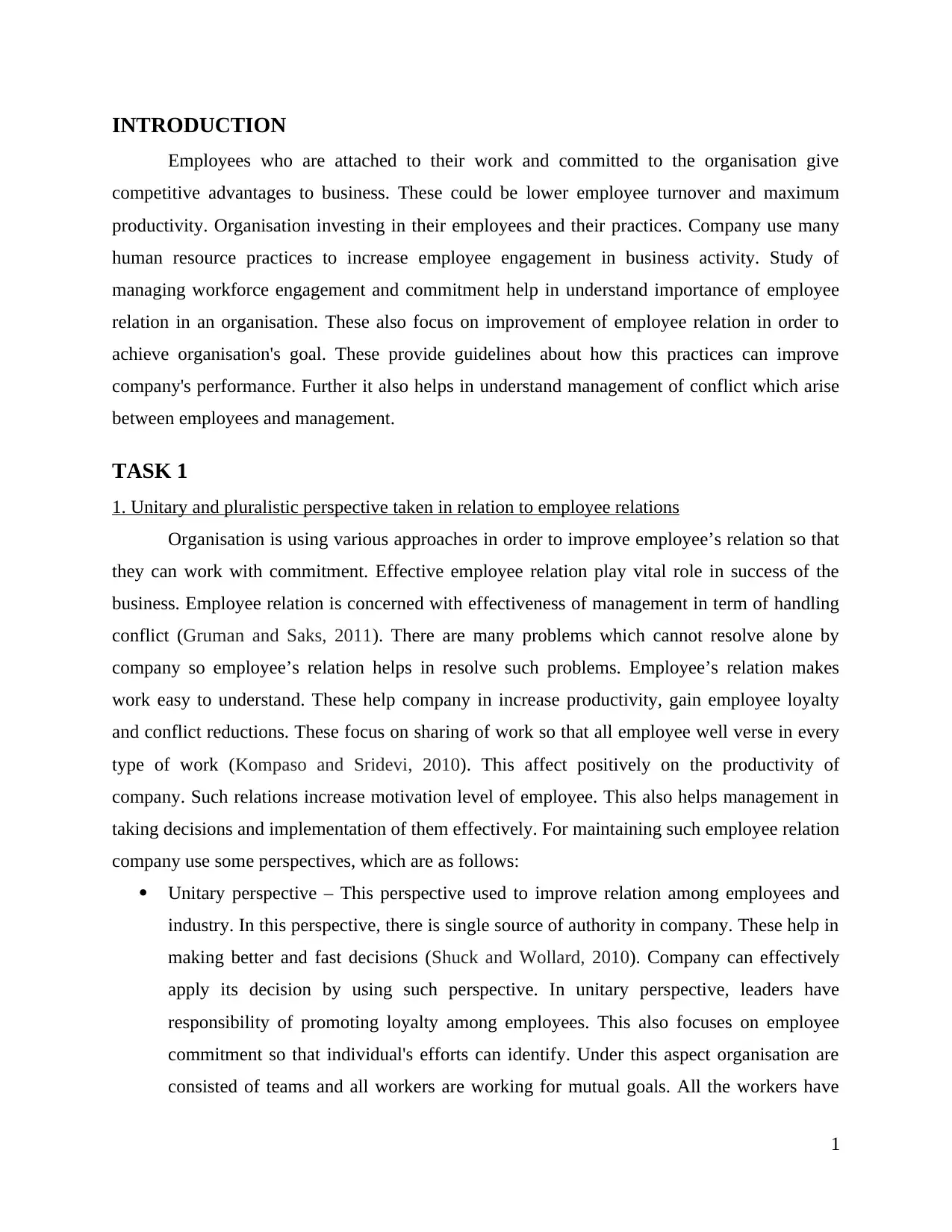
INTRODUCTION
Employees who are attached to their work and committed to the organisation give
competitive advantages to business. These could be lower employee turnover and maximum
productivity. Organisation investing in their employees and their practices. Company use many
human resource practices to increase employee engagement in business activity. Study of
managing workforce engagement and commitment help in understand importance of employee
relation in an organisation. These also focus on improvement of employee relation in order to
achieve organisation's goal. These provide guidelines about how this practices can improve
company's performance. Further it also helps in understand management of conflict which arise
between employees and management.
TASK 1
1. Unitary and pluralistic perspective taken in relation to employee relations
Organisation is using various approaches in order to improve employee’s relation so that
they can work with commitment. Effective employee relation play vital role in success of the
business. Employee relation is concerned with effectiveness of management in term of handling
conflict (Gruman and Saks, 2011). There are many problems which cannot resolve alone by
company so employee’s relation helps in resolve such problems. Employee’s relation makes
work easy to understand. These help company in increase productivity, gain employee loyalty
and conflict reductions. These focus on sharing of work so that all employee well verse in every
type of work (Kompaso and Sridevi, 2010). This affect positively on the productivity of
company. Such relations increase motivation level of employee. This also helps management in
taking decisions and implementation of them effectively. For maintaining such employee relation
company use some perspectives, which are as follows:
Unitary perspective – This perspective used to improve relation among employees and
industry. In this perspective, there is single source of authority in company. These help in
making better and fast decisions (Shuck and Wollard, 2010). Company can effectively
apply its decision by using such perspective. In unitary perspective, leaders have
responsibility of promoting loyalty among employees. This also focuses on employee
commitment so that individual's efforts can identify. Under this aspect organisation are
consisted of teams and all workers are working for mutual goals. All the workers have
1
Employees who are attached to their work and committed to the organisation give
competitive advantages to business. These could be lower employee turnover and maximum
productivity. Organisation investing in their employees and their practices. Company use many
human resource practices to increase employee engagement in business activity. Study of
managing workforce engagement and commitment help in understand importance of employee
relation in an organisation. These also focus on improvement of employee relation in order to
achieve organisation's goal. These provide guidelines about how this practices can improve
company's performance. Further it also helps in understand management of conflict which arise
between employees and management.
TASK 1
1. Unitary and pluralistic perspective taken in relation to employee relations
Organisation is using various approaches in order to improve employee’s relation so that
they can work with commitment. Effective employee relation play vital role in success of the
business. Employee relation is concerned with effectiveness of management in term of handling
conflict (Gruman and Saks, 2011). There are many problems which cannot resolve alone by
company so employee’s relation helps in resolve such problems. Employee’s relation makes
work easy to understand. These help company in increase productivity, gain employee loyalty
and conflict reductions. These focus on sharing of work so that all employee well verse in every
type of work (Kompaso and Sridevi, 2010). This affect positively on the productivity of
company. Such relations increase motivation level of employee. This also helps management in
taking decisions and implementation of them effectively. For maintaining such employee relation
company use some perspectives, which are as follows:
Unitary perspective – This perspective used to improve relation among employees and
industry. In this perspective, there is single source of authority in company. These help in
making better and fast decisions (Shuck and Wollard, 2010). Company can effectively
apply its decision by using such perspective. In unitary perspective, leaders have
responsibility of promoting loyalty among employees. This also focuses on employee
commitment so that individual's efforts can identify. Under this aspect organisation are
consisted of teams and all workers are working for mutual goals. All the workers have
1
⊘ This is a preview!⊘
Do you want full access?
Subscribe today to unlock all pages.

Trusted by 1+ million students worldwide
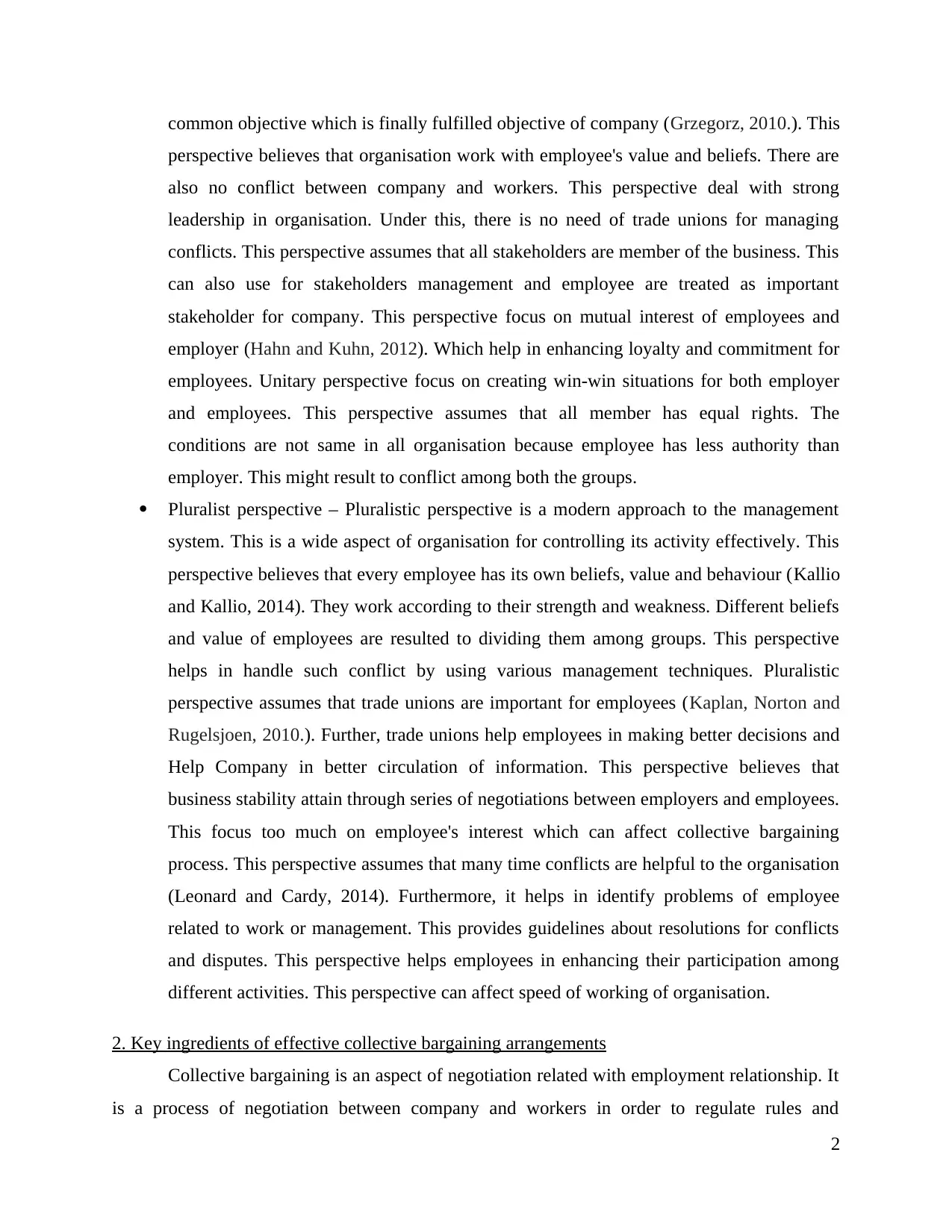
common objective which is finally fulfilled objective of company (Grzegorz, 2010.). This
perspective believes that organisation work with employee's value and beliefs. There are
also no conflict between company and workers. This perspective deal with strong
leadership in organisation. Under this, there is no need of trade unions for managing
conflicts. This perspective assumes that all stakeholders are member of the business. This
can also use for stakeholders management and employee are treated as important
stakeholder for company. This perspective focus on mutual interest of employees and
employer (Hahn and Kuhn, 2012). Which help in enhancing loyalty and commitment for
employees. Unitary perspective focus on creating win-win situations for both employer
and employees. This perspective assumes that all member has equal rights. The
conditions are not same in all organisation because employee has less authority than
employer. This might result to conflict among both the groups.
Pluralist perspective – Pluralistic perspective is a modern approach to the management
system. This is a wide aspect of organisation for controlling its activity effectively. This
perspective believes that every employee has its own beliefs, value and behaviour (Kallio
and Kallio, 2014). They work according to their strength and weakness. Different beliefs
and value of employees are resulted to dividing them among groups. This perspective
helps in handle such conflict by using various management techniques. Pluralistic
perspective assumes that trade unions are important for employees (Kaplan, Norton and
Rugelsjoen, 2010.). Further, trade unions help employees in making better decisions and
Help Company in better circulation of information. This perspective believes that
business stability attain through series of negotiations between employers and employees.
This focus too much on employee's interest which can affect collective bargaining
process. This perspective assumes that many time conflicts are helpful to the organisation
(Leonard and Cardy, 2014). Furthermore, it helps in identify problems of employee
related to work or management. This provides guidelines about resolutions for conflicts
and disputes. This perspective helps employees in enhancing their participation among
different activities. This perspective can affect speed of working of organisation.
2. Key ingredients of effective collective bargaining arrangements
Collective bargaining is an aspect of negotiation related with employment relationship. It
is a process of negotiation between company and workers in order to regulate rules and
2
perspective believes that organisation work with employee's value and beliefs. There are
also no conflict between company and workers. This perspective deal with strong
leadership in organisation. Under this, there is no need of trade unions for managing
conflicts. This perspective assumes that all stakeholders are member of the business. This
can also use for stakeholders management and employee are treated as important
stakeholder for company. This perspective focus on mutual interest of employees and
employer (Hahn and Kuhn, 2012). Which help in enhancing loyalty and commitment for
employees. Unitary perspective focus on creating win-win situations for both employer
and employees. This perspective assumes that all member has equal rights. The
conditions are not same in all organisation because employee has less authority than
employer. This might result to conflict among both the groups.
Pluralist perspective – Pluralistic perspective is a modern approach to the management
system. This is a wide aspect of organisation for controlling its activity effectively. This
perspective believes that every employee has its own beliefs, value and behaviour (Kallio
and Kallio, 2014). They work according to their strength and weakness. Different beliefs
and value of employees are resulted to dividing them among groups. This perspective
helps in handle such conflict by using various management techniques. Pluralistic
perspective assumes that trade unions are important for employees (Kaplan, Norton and
Rugelsjoen, 2010.). Further, trade unions help employees in making better decisions and
Help Company in better circulation of information. This perspective believes that
business stability attain through series of negotiations between employers and employees.
This focus too much on employee's interest which can affect collective bargaining
process. This perspective assumes that many time conflicts are helpful to the organisation
(Leonard and Cardy, 2014). Furthermore, it helps in identify problems of employee
related to work or management. This provides guidelines about resolutions for conflicts
and disputes. This perspective helps employees in enhancing their participation among
different activities. This perspective can affect speed of working of organisation.
2. Key ingredients of effective collective bargaining arrangements
Collective bargaining is an aspect of negotiation related with employment relationship. It
is a process of negotiation between company and workers in order to regulate rules and
2
Paraphrase This Document
Need a fresh take? Get an instant paraphrase of this document with our AI Paraphraser
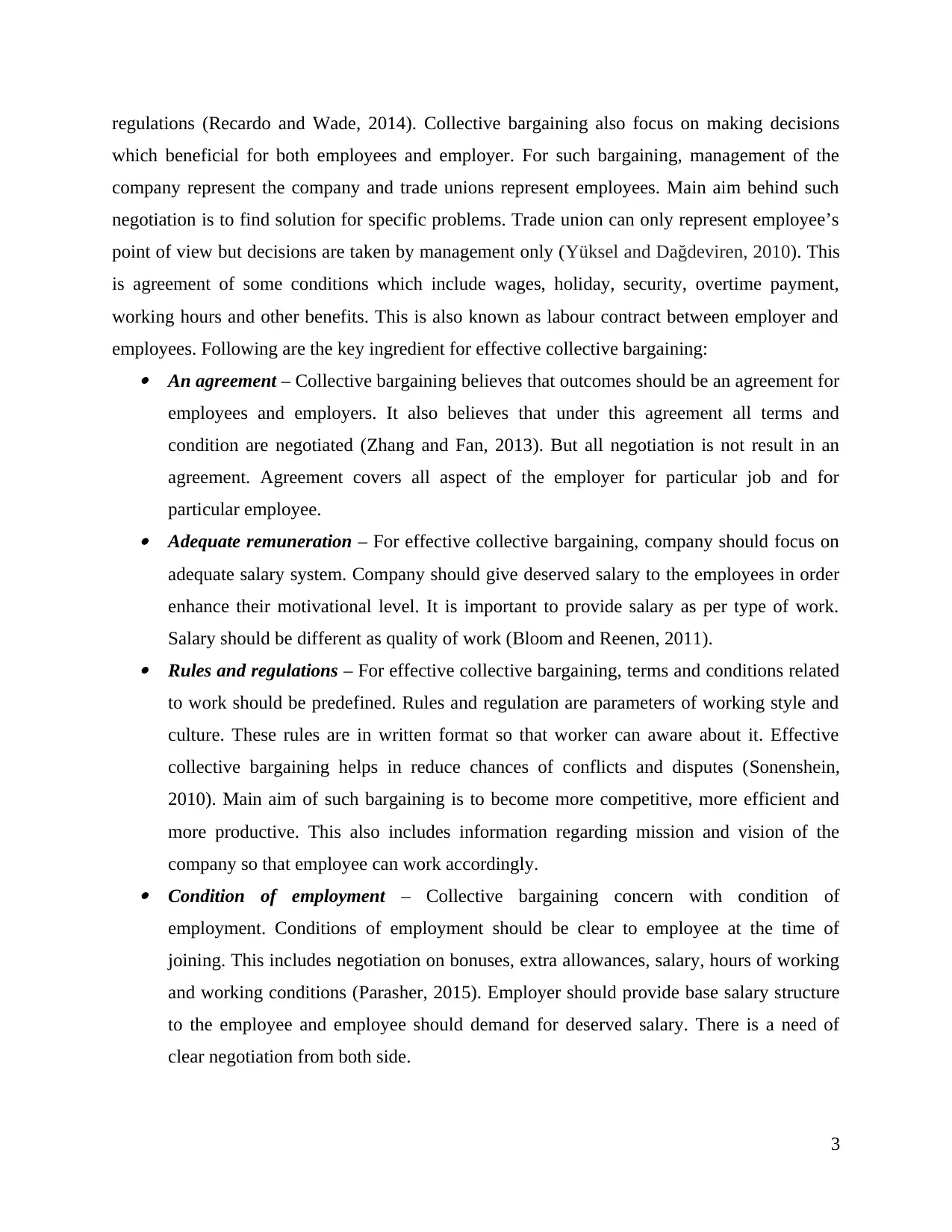
regulations (Recardo and Wade, 2014). Collective bargaining also focus on making decisions
which beneficial for both employees and employer. For such bargaining, management of the
company represent the company and trade unions represent employees. Main aim behind such
negotiation is to find solution for specific problems. Trade union can only represent employee’s
point of view but decisions are taken by management only (Yüksel and Dağdeviren, 2010). This
is agreement of some conditions which include wages, holiday, security, overtime payment,
working hours and other benefits. This is also known as labour contract between employer and
employees. Following are the key ingredient for effective collective bargaining: An agreement – Collective bargaining believes that outcomes should be an agreement for
employees and employers. It also believes that under this agreement all terms and
condition are negotiated (Zhang and Fan, 2013). But all negotiation is not result in an
agreement. Agreement covers all aspect of the employer for particular job and for
particular employee. Adequate remuneration – For effective collective bargaining, company should focus on
adequate salary system. Company should give deserved salary to the employees in order
enhance their motivational level. It is important to provide salary as per type of work.
Salary should be different as quality of work (Bloom and Reenen, 2011). Rules and regulations – For effective collective bargaining, terms and conditions related
to work should be predefined. Rules and regulation are parameters of working style and
culture. These rules are in written format so that worker can aware about it. Effective
collective bargaining helps in reduce chances of conflicts and disputes (Sonenshein,
2010). Main aim of such bargaining is to become more competitive, more efficient and
more productive. This also includes information regarding mission and vision of the
company so that employee can work accordingly. Condition of employment – Collective bargaining concern with condition of
employment. Conditions of employment should be clear to employee at the time of
joining. This includes negotiation on bonuses, extra allowances, salary, hours of working
and working conditions (Parasher, 2015). Employer should provide base salary structure
to the employee and employee should demand for deserved salary. There is a need of
clear negotiation from both side.
3
which beneficial for both employees and employer. For such bargaining, management of the
company represent the company and trade unions represent employees. Main aim behind such
negotiation is to find solution for specific problems. Trade union can only represent employee’s
point of view but decisions are taken by management only (Yüksel and Dağdeviren, 2010). This
is agreement of some conditions which include wages, holiday, security, overtime payment,
working hours and other benefits. This is also known as labour contract between employer and
employees. Following are the key ingredient for effective collective bargaining: An agreement – Collective bargaining believes that outcomes should be an agreement for
employees and employers. It also believes that under this agreement all terms and
condition are negotiated (Zhang and Fan, 2013). But all negotiation is not result in an
agreement. Agreement covers all aspect of the employer for particular job and for
particular employee. Adequate remuneration – For effective collective bargaining, company should focus on
adequate salary system. Company should give deserved salary to the employees in order
enhance their motivational level. It is important to provide salary as per type of work.
Salary should be different as quality of work (Bloom and Reenen, 2011). Rules and regulations – For effective collective bargaining, terms and conditions related
to work should be predefined. Rules and regulation are parameters of working style and
culture. These rules are in written format so that worker can aware about it. Effective
collective bargaining helps in reduce chances of conflicts and disputes (Sonenshein,
2010). Main aim of such bargaining is to become more competitive, more efficient and
more productive. This also includes information regarding mission and vision of the
company so that employee can work accordingly. Condition of employment – Collective bargaining concern with condition of
employment. Conditions of employment should be clear to employee at the time of
joining. This includes negotiation on bonuses, extra allowances, salary, hours of working
and working conditions (Parasher, 2015). Employer should provide base salary structure
to the employee and employee should demand for deserved salary. There is a need of
clear negotiation from both side.
3
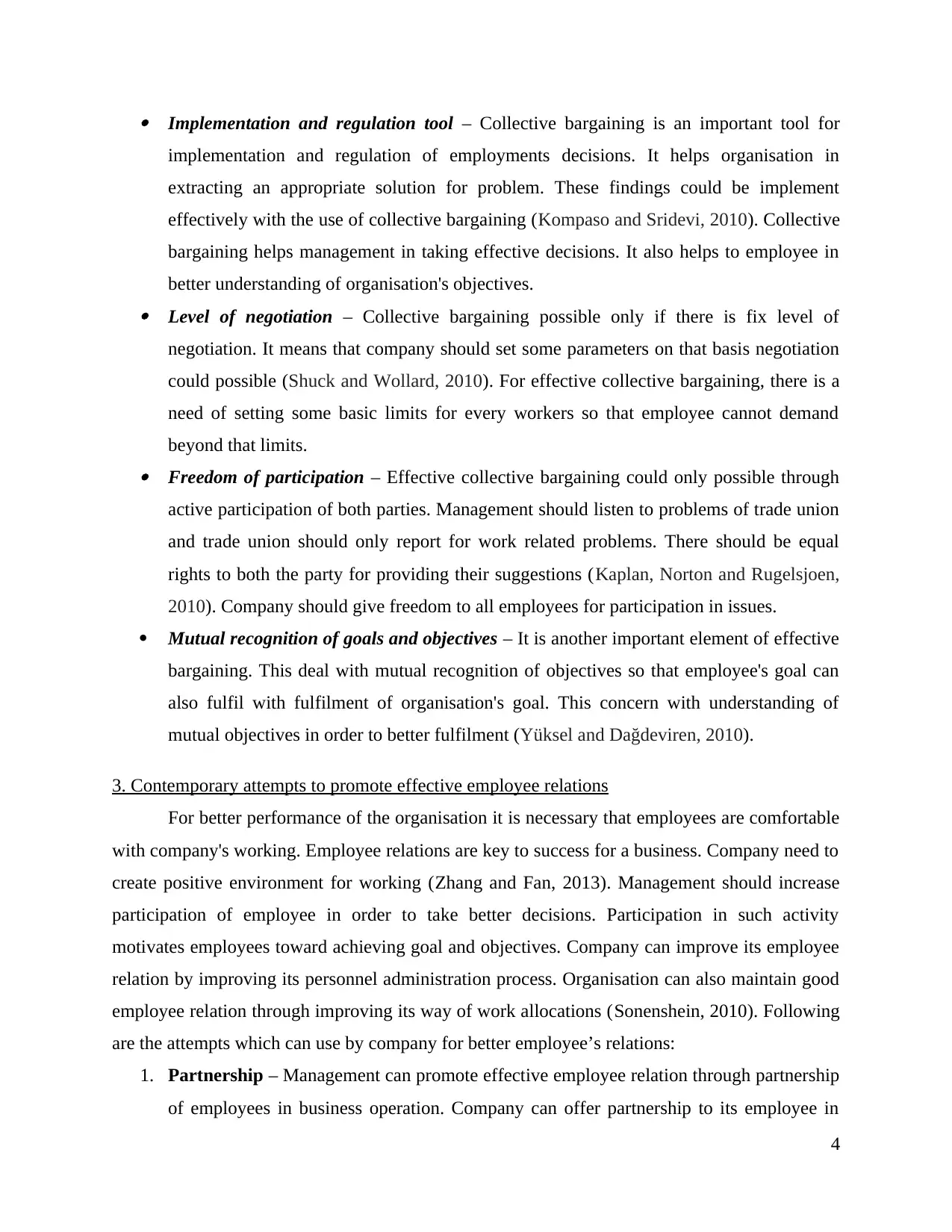
Implementation and regulation tool – Collective bargaining is an important tool for
implementation and regulation of employments decisions. It helps organisation in
extracting an appropriate solution for problem. These findings could be implement
effectively with the use of collective bargaining (Kompaso and Sridevi, 2010). Collective
bargaining helps management in taking effective decisions. It also helps to employee in
better understanding of organisation's objectives. Level of negotiation – Collective bargaining possible only if there is fix level of
negotiation. It means that company should set some parameters on that basis negotiation
could possible (Shuck and Wollard, 2010). For effective collective bargaining, there is a
need of setting some basic limits for every workers so that employee cannot demand
beyond that limits. Freedom of participation – Effective collective bargaining could only possible through
active participation of both parties. Management should listen to problems of trade union
and trade union should only report for work related problems. There should be equal
rights to both the party for providing their suggestions (Kaplan, Norton and Rugelsjoen,
2010). Company should give freedom to all employees for participation in issues.
Mutual recognition of goals and objectives – It is another important element of effective
bargaining. This deal with mutual recognition of objectives so that employee's goal can
also fulfil with fulfilment of organisation's goal. This concern with understanding of
mutual objectives in order to better fulfilment (Yüksel and Dağdeviren, 2010).
3. Contemporary attempts to promote effective employee relations
For better performance of the organisation it is necessary that employees are comfortable
with company's working. Employee relations are key to success for a business. Company need to
create positive environment for working (Zhang and Fan, 2013). Management should increase
participation of employee in order to take better decisions. Participation in such activity
motivates employees toward achieving goal and objectives. Company can improve its employee
relation by improving its personnel administration process. Organisation can also maintain good
employee relation through improving its way of work allocations (Sonenshein, 2010). Following
are the attempts which can use by company for better employee’s relations:
1. Partnership – Management can promote effective employee relation through partnership
of employees in business operation. Company can offer partnership to its employee in
4
implementation and regulation of employments decisions. It helps organisation in
extracting an appropriate solution for problem. These findings could be implement
effectively with the use of collective bargaining (Kompaso and Sridevi, 2010). Collective
bargaining helps management in taking effective decisions. It also helps to employee in
better understanding of organisation's objectives. Level of negotiation – Collective bargaining possible only if there is fix level of
negotiation. It means that company should set some parameters on that basis negotiation
could possible (Shuck and Wollard, 2010). For effective collective bargaining, there is a
need of setting some basic limits for every workers so that employee cannot demand
beyond that limits. Freedom of participation – Effective collective bargaining could only possible through
active participation of both parties. Management should listen to problems of trade union
and trade union should only report for work related problems. There should be equal
rights to both the party for providing their suggestions (Kaplan, Norton and Rugelsjoen,
2010). Company should give freedom to all employees for participation in issues.
Mutual recognition of goals and objectives – It is another important element of effective
bargaining. This deal with mutual recognition of objectives so that employee's goal can
also fulfil with fulfilment of organisation's goal. This concern with understanding of
mutual objectives in order to better fulfilment (Yüksel and Dağdeviren, 2010).
3. Contemporary attempts to promote effective employee relations
For better performance of the organisation it is necessary that employees are comfortable
with company's working. Employee relations are key to success for a business. Company need to
create positive environment for working (Zhang and Fan, 2013). Management should increase
participation of employee in order to take better decisions. Participation in such activity
motivates employees toward achieving goal and objectives. Company can improve its employee
relation by improving its personnel administration process. Organisation can also maintain good
employee relation through improving its way of work allocations (Sonenshein, 2010). Following
are the attempts which can use by company for better employee’s relations:
1. Partnership – Management can promote effective employee relation through partnership
of employees in business operation. Company can offer partnership to its employee in
4
⊘ This is a preview!⊘
Do you want full access?
Subscribe today to unlock all pages.

Trusted by 1+ million students worldwide
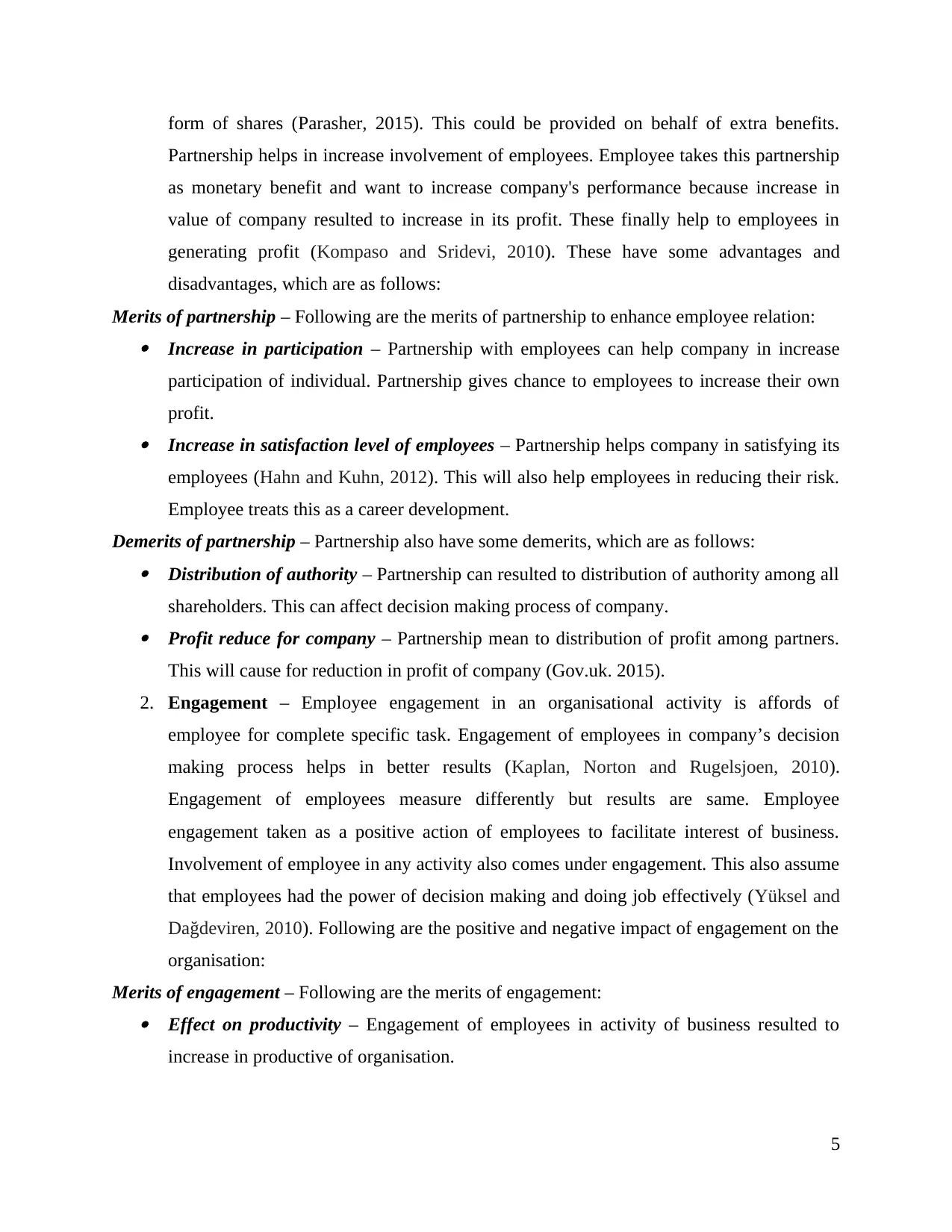
form of shares (Parasher, 2015). This could be provided on behalf of extra benefits.
Partnership helps in increase involvement of employees. Employee takes this partnership
as monetary benefit and want to increase company's performance because increase in
value of company resulted to increase in its profit. These finally help to employees in
generating profit (Kompaso and Sridevi, 2010). These have some advantages and
disadvantages, which are as follows:
Merits of partnership – Following are the merits of partnership to enhance employee relation: Increase in participation – Partnership with employees can help company in increase
participation of individual. Partnership gives chance to employees to increase their own
profit. Increase in satisfaction level of employees – Partnership helps company in satisfying its
employees (Hahn and Kuhn, 2012). This will also help employees in reducing their risk.
Employee treats this as a career development.
Demerits of partnership – Partnership also have some demerits, which are as follows: Distribution of authority – Partnership can resulted to distribution of authority among all
shareholders. This can affect decision making process of company. Profit reduce for company – Partnership mean to distribution of profit among partners.
This will cause for reduction in profit of company (Gov.uk. 2015).
2. Engagement – Employee engagement in an organisational activity is affords of
employee for complete specific task. Engagement of employees in company’s decision
making process helps in better results (Kaplan, Norton and Rugelsjoen, 2010).
Engagement of employees measure differently but results are same. Employee
engagement taken as a positive action of employees to facilitate interest of business.
Involvement of employee in any activity also comes under engagement. This also assume
that employees had the power of decision making and doing job effectively (Yüksel and
Dağdeviren, 2010). Following are the positive and negative impact of engagement on the
organisation:
Merits of engagement – Following are the merits of engagement: Effect on productivity – Engagement of employees in activity of business resulted to
increase in productive of organisation.
5
Partnership helps in increase involvement of employees. Employee takes this partnership
as monetary benefit and want to increase company's performance because increase in
value of company resulted to increase in its profit. These finally help to employees in
generating profit (Kompaso and Sridevi, 2010). These have some advantages and
disadvantages, which are as follows:
Merits of partnership – Following are the merits of partnership to enhance employee relation: Increase in participation – Partnership with employees can help company in increase
participation of individual. Partnership gives chance to employees to increase their own
profit. Increase in satisfaction level of employees – Partnership helps company in satisfying its
employees (Hahn and Kuhn, 2012). This will also help employees in reducing their risk.
Employee treats this as a career development.
Demerits of partnership – Partnership also have some demerits, which are as follows: Distribution of authority – Partnership can resulted to distribution of authority among all
shareholders. This can affect decision making process of company. Profit reduce for company – Partnership mean to distribution of profit among partners.
This will cause for reduction in profit of company (Gov.uk. 2015).
2. Engagement – Employee engagement in an organisational activity is affords of
employee for complete specific task. Engagement of employees in company’s decision
making process helps in better results (Kaplan, Norton and Rugelsjoen, 2010).
Engagement of employees measure differently but results are same. Employee
engagement taken as a positive action of employees to facilitate interest of business.
Involvement of employee in any activity also comes under engagement. This also assume
that employees had the power of decision making and doing job effectively (Yüksel and
Dağdeviren, 2010). Following are the positive and negative impact of engagement on the
organisation:
Merits of engagement – Following are the merits of engagement: Effect on productivity – Engagement of employees in activity of business resulted to
increase in productive of organisation.
5
Paraphrase This Document
Need a fresh take? Get an instant paraphrase of this document with our AI Paraphraser
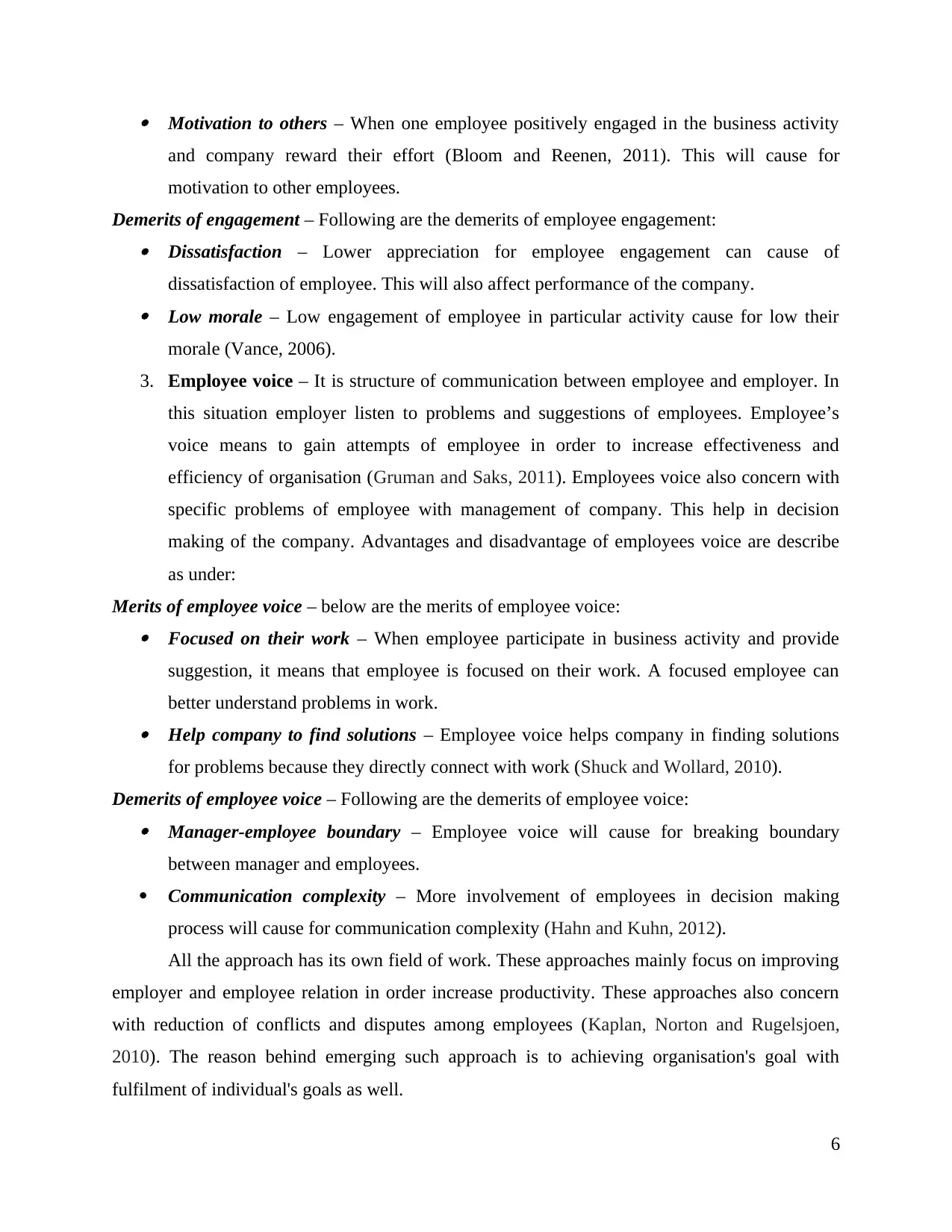
Motivation to others – When one employee positively engaged in the business activity
and company reward their effort (Bloom and Reenen, 2011). This will cause for
motivation to other employees.
Demerits of engagement – Following are the demerits of employee engagement: Dissatisfaction – Lower appreciation for employee engagement can cause of
dissatisfaction of employee. This will also affect performance of the company. Low morale – Low engagement of employee in particular activity cause for low their
morale (Vance, 2006).
3. Employee voice – It is structure of communication between employee and employer. In
this situation employer listen to problems and suggestions of employees. Employee’s
voice means to gain attempts of employee in order to increase effectiveness and
efficiency of organisation (Gruman and Saks, 2011). Employees voice also concern with
specific problems of employee with management of company. This help in decision
making of the company. Advantages and disadvantage of employees voice are describe
as under:
Merits of employee voice – below are the merits of employee voice: Focused on their work – When employee participate in business activity and provide
suggestion, it means that employee is focused on their work. A focused employee can
better understand problems in work. Help company to find solutions – Employee voice helps company in finding solutions
for problems because they directly connect with work (Shuck and Wollard, 2010).
Demerits of employee voice – Following are the demerits of employee voice: Manager-employee boundary – Employee voice will cause for breaking boundary
between manager and employees.
Communication complexity – More involvement of employees in decision making
process will cause for communication complexity (Hahn and Kuhn, 2012).
All the approach has its own field of work. These approaches mainly focus on improving
employer and employee relation in order increase productivity. These approaches also concern
with reduction of conflicts and disputes among employees (Kaplan, Norton and Rugelsjoen,
2010). The reason behind emerging such approach is to achieving organisation's goal with
fulfilment of individual's goals as well.
6
and company reward their effort (Bloom and Reenen, 2011). This will cause for
motivation to other employees.
Demerits of engagement – Following are the demerits of employee engagement: Dissatisfaction – Lower appreciation for employee engagement can cause of
dissatisfaction of employee. This will also affect performance of the company. Low morale – Low engagement of employee in particular activity cause for low their
morale (Vance, 2006).
3. Employee voice – It is structure of communication between employee and employer. In
this situation employer listen to problems and suggestions of employees. Employee’s
voice means to gain attempts of employee in order to increase effectiveness and
efficiency of organisation (Gruman and Saks, 2011). Employees voice also concern with
specific problems of employee with management of company. This help in decision
making of the company. Advantages and disadvantage of employees voice are describe
as under:
Merits of employee voice – below are the merits of employee voice: Focused on their work – When employee participate in business activity and provide
suggestion, it means that employee is focused on their work. A focused employee can
better understand problems in work. Help company to find solutions – Employee voice helps company in finding solutions
for problems because they directly connect with work (Shuck and Wollard, 2010).
Demerits of employee voice – Following are the demerits of employee voice: Manager-employee boundary – Employee voice will cause for breaking boundary
between manager and employees.
Communication complexity – More involvement of employees in decision making
process will cause for communication complexity (Hahn and Kuhn, 2012).
All the approach has its own field of work. These approaches mainly focus on improving
employer and employee relation in order increase productivity. These approaches also concern
with reduction of conflicts and disputes among employees (Kaplan, Norton and Rugelsjoen,
2010). The reason behind emerging such approach is to achieving organisation's goal with
fulfilment of individual's goals as well.
6
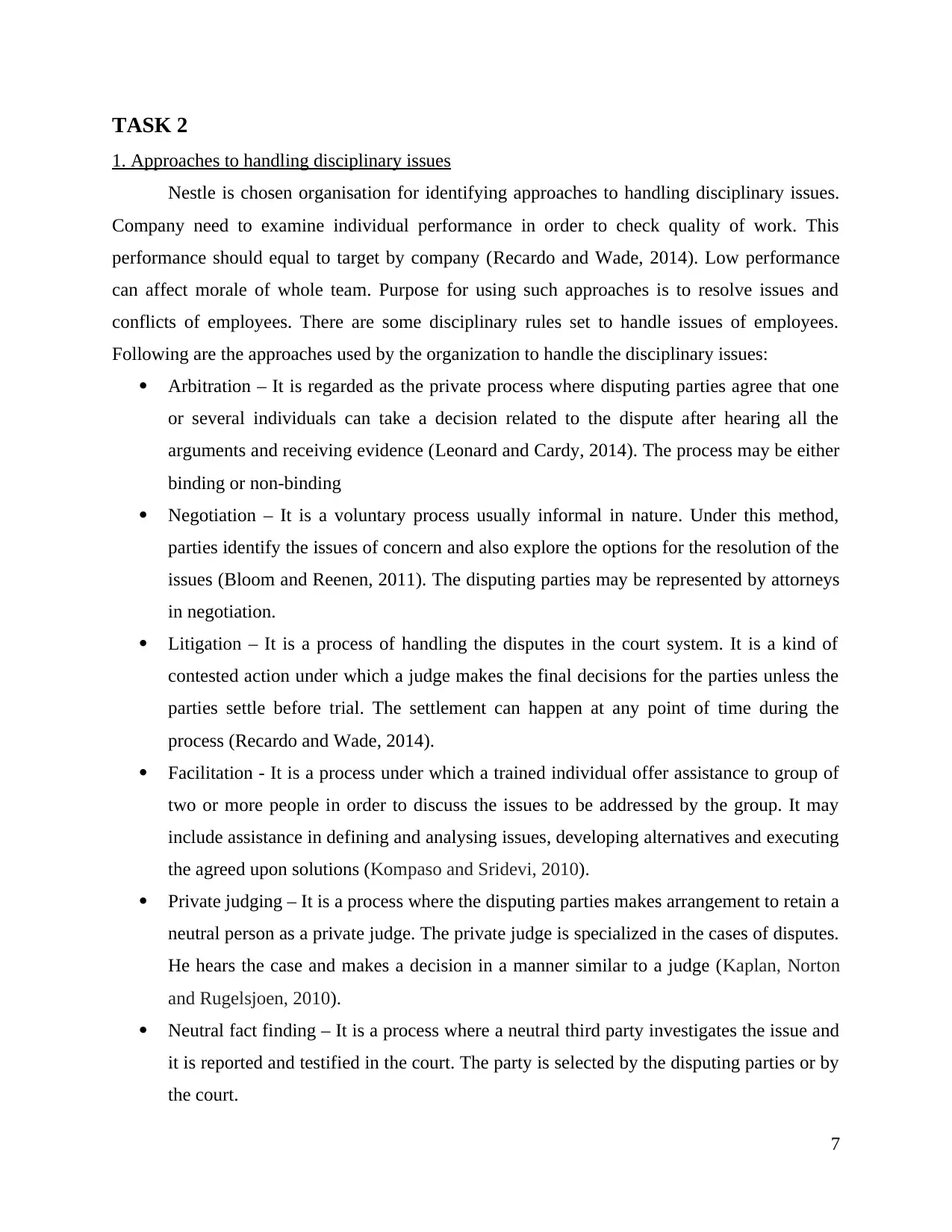
TASK 2
1. Approaches to handling disciplinary issues
Nestle is chosen organisation for identifying approaches to handling disciplinary issues.
Company need to examine individual performance in order to check quality of work. This
performance should equal to target by company (Recardo and Wade, 2014). Low performance
can affect morale of whole team. Purpose for using such approaches is to resolve issues and
conflicts of employees. There are some disciplinary rules set to handle issues of employees.
Following are the approaches used by the organization to handle the disciplinary issues:
Arbitration – It is regarded as the private process where disputing parties agree that one
or several individuals can take a decision related to the dispute after hearing all the
arguments and receiving evidence (Leonard and Cardy, 2014). The process may be either
binding or non-binding
Negotiation – It is a voluntary process usually informal in nature. Under this method,
parties identify the issues of concern and also explore the options for the resolution of the
issues (Bloom and Reenen, 2011). The disputing parties may be represented by attorneys
in negotiation.
Litigation – It is a process of handling the disputes in the court system. It is a kind of
contested action under which a judge makes the final decisions for the parties unless the
parties settle before trial. The settlement can happen at any point of time during the
process (Recardo and Wade, 2014).
Facilitation - It is a process under which a trained individual offer assistance to group of
two or more people in order to discuss the issues to be addressed by the group. It may
include assistance in defining and analysing issues, developing alternatives and executing
the agreed upon solutions (Kompaso and Sridevi, 2010).
Private judging – It is a process where the disputing parties makes arrangement to retain a
neutral person as a private judge. The private judge is specialized in the cases of disputes.
He hears the case and makes a decision in a manner similar to a judge (Kaplan, Norton
and Rugelsjoen, 2010).
Neutral fact finding – It is a process where a neutral third party investigates the issue and
it is reported and testified in the court. The party is selected by the disputing parties or by
the court.
7
1. Approaches to handling disciplinary issues
Nestle is chosen organisation for identifying approaches to handling disciplinary issues.
Company need to examine individual performance in order to check quality of work. This
performance should equal to target by company (Recardo and Wade, 2014). Low performance
can affect morale of whole team. Purpose for using such approaches is to resolve issues and
conflicts of employees. There are some disciplinary rules set to handle issues of employees.
Following are the approaches used by the organization to handle the disciplinary issues:
Arbitration – It is regarded as the private process where disputing parties agree that one
or several individuals can take a decision related to the dispute after hearing all the
arguments and receiving evidence (Leonard and Cardy, 2014). The process may be either
binding or non-binding
Negotiation – It is a voluntary process usually informal in nature. Under this method,
parties identify the issues of concern and also explore the options for the resolution of the
issues (Bloom and Reenen, 2011). The disputing parties may be represented by attorneys
in negotiation.
Litigation – It is a process of handling the disputes in the court system. It is a kind of
contested action under which a judge makes the final decisions for the parties unless the
parties settle before trial. The settlement can happen at any point of time during the
process (Recardo and Wade, 2014).
Facilitation - It is a process under which a trained individual offer assistance to group of
two or more people in order to discuss the issues to be addressed by the group. It may
include assistance in defining and analysing issues, developing alternatives and executing
the agreed upon solutions (Kompaso and Sridevi, 2010).
Private judging – It is a process where the disputing parties makes arrangement to retain a
neutral person as a private judge. The private judge is specialized in the cases of disputes.
He hears the case and makes a decision in a manner similar to a judge (Kaplan, Norton
and Rugelsjoen, 2010).
Neutral fact finding – It is a process where a neutral third party investigates the issue and
it is reported and testified in the court. The party is selected by the disputing parties or by
the court.
7
⊘ This is a preview!⊘
Do you want full access?
Subscribe today to unlock all pages.

Trusted by 1+ million students worldwide
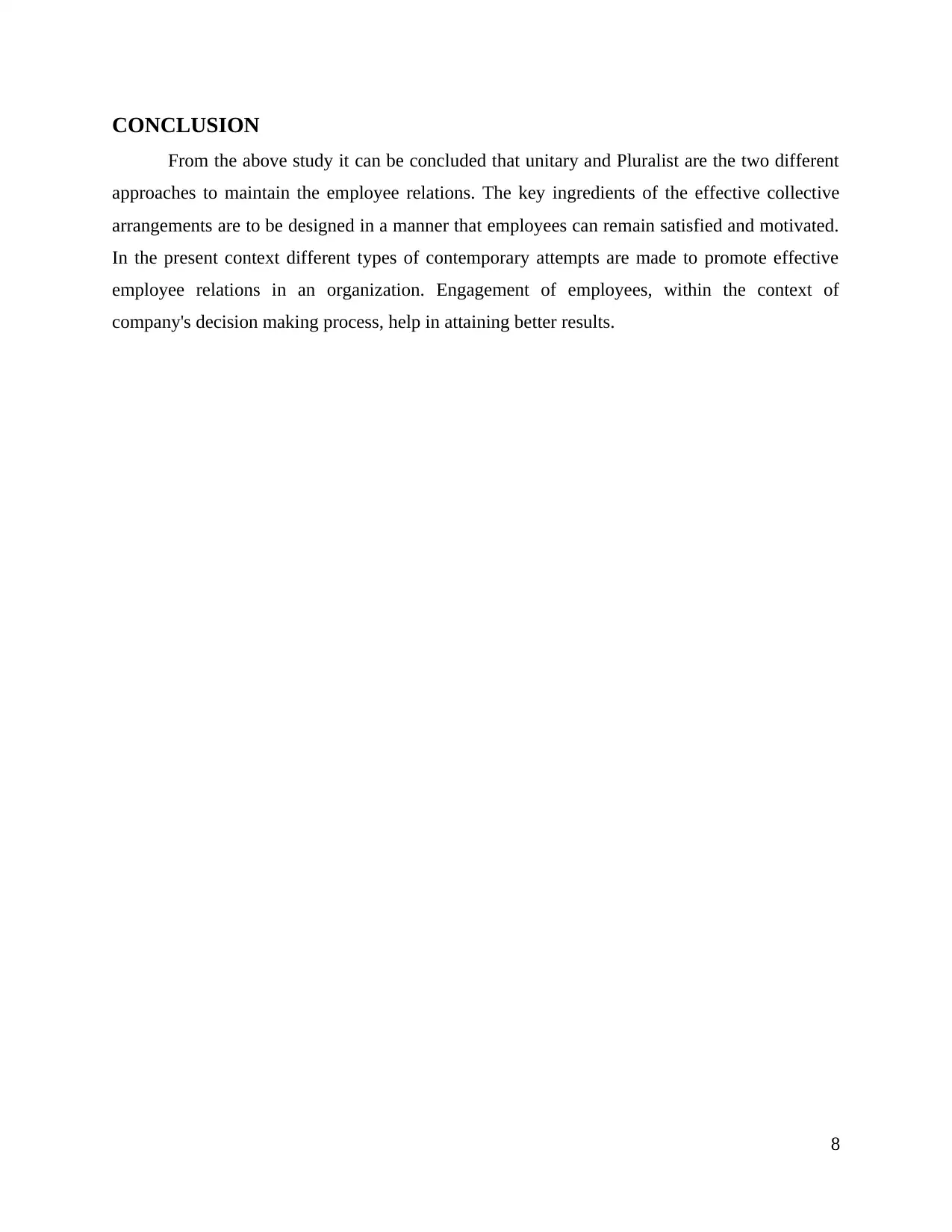
CONCLUSION
From the above study it can be concluded that unitary and Pluralist are the two different
approaches to maintain the employee relations. The key ingredients of the effective collective
arrangements are to be designed in a manner that employees can remain satisfied and motivated.
In the present context different types of contemporary attempts are made to promote effective
employee relations in an organization. Engagement of employees, within the context of
company's decision making process, help in attaining better results.
8
From the above study it can be concluded that unitary and Pluralist are the two different
approaches to maintain the employee relations. The key ingredients of the effective collective
arrangements are to be designed in a manner that employees can remain satisfied and motivated.
In the present context different types of contemporary attempts are made to promote effective
employee relations in an organization. Engagement of employees, within the context of
company's decision making process, help in attaining better results.
8
Paraphrase This Document
Need a fresh take? Get an instant paraphrase of this document with our AI Paraphraser
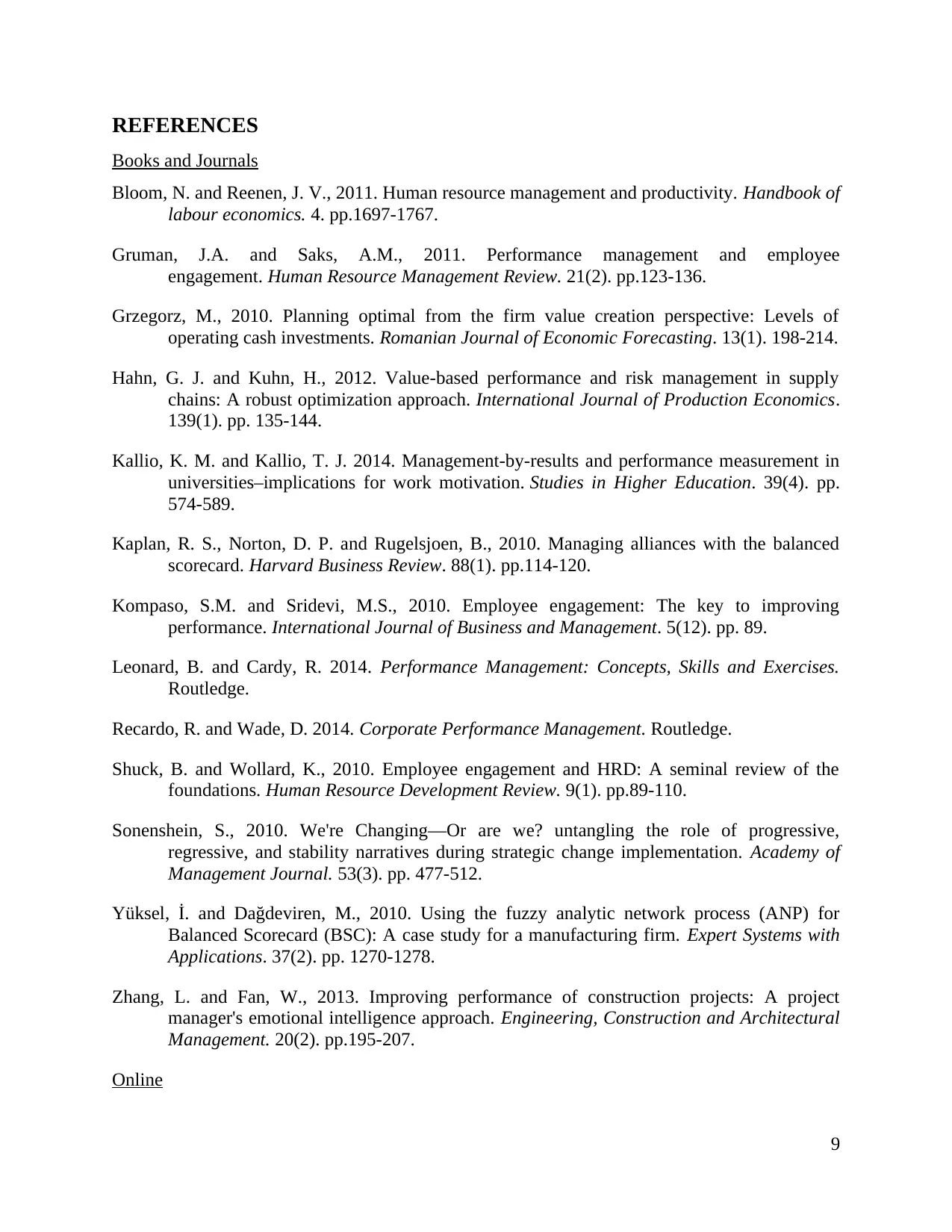
REFERENCES
Books and Journals
Bloom, N. and Reenen, J. V., 2011. Human resource management and productivity. Handbook of
labour economics. 4. pp.1697-1767.
Gruman, J.A. and Saks, A.M., 2011. Performance management and employee
engagement. Human Resource Management Review. 21(2). pp.123-136.
Grzegorz, M., 2010. Planning optimal from the firm value creation perspective: Levels of
operating cash investments. Romanian Journal of Economic Forecasting. 13(1). 198-214.
Hahn, G. J. and Kuhn, H., 2012. Value-based performance and risk management in supply
chains: A robust optimization approach. International Journal of Production Economics.
139(1). pp. 135-144.
Kallio, K. M. and Kallio, T. J. 2014. Management-by-results and performance measurement in
universities–implications for work motivation. Studies in Higher Education. 39(4). pp.
574-589.
Kaplan, R. S., Norton, D. P. and Rugelsjoen, B., 2010. Managing alliances with the balanced
scorecard. Harvard Business Review. 88(1). pp.114-120.
Kompaso, S.M. and Sridevi, M.S., 2010. Employee engagement: The key to improving
performance. International Journal of Business and Management. 5(12). pp. 89.
Leonard, B. and Cardy, R. 2014. Performance Management: Concepts, Skills and Exercises.
Routledge.
Recardo, R. and Wade, D. 2014. Corporate Performance Management. Routledge.
Shuck, B. and Wollard, K., 2010. Employee engagement and HRD: A seminal review of the
foundations. Human Resource Development Review. 9(1). pp.89-110.
Sonenshein, S., 2010. We're Changing—Or are we? untangling the role of progressive,
regressive, and stability narratives during strategic change implementation. Academy of
Management Journal. 53(3). pp. 477-512.
Yüksel, İ. and Dağdeviren, M., 2010. Using the fuzzy analytic network process (ANP) for
Balanced Scorecard (BSC): A case study for a manufacturing firm. Expert Systems with
Applications. 37(2). pp. 1270-1278.
Zhang, L. and Fan, W., 2013. Improving performance of construction projects: A project
manager's emotional intelligence approach. Engineering, Construction and Architectural
Management. 20(2). pp.195-207.
Online
9
Books and Journals
Bloom, N. and Reenen, J. V., 2011. Human resource management and productivity. Handbook of
labour economics. 4. pp.1697-1767.
Gruman, J.A. and Saks, A.M., 2011. Performance management and employee
engagement. Human Resource Management Review. 21(2). pp.123-136.
Grzegorz, M., 2010. Planning optimal from the firm value creation perspective: Levels of
operating cash investments. Romanian Journal of Economic Forecasting. 13(1). 198-214.
Hahn, G. J. and Kuhn, H., 2012. Value-based performance and risk management in supply
chains: A robust optimization approach. International Journal of Production Economics.
139(1). pp. 135-144.
Kallio, K. M. and Kallio, T. J. 2014. Management-by-results and performance measurement in
universities–implications for work motivation. Studies in Higher Education. 39(4). pp.
574-589.
Kaplan, R. S., Norton, D. P. and Rugelsjoen, B., 2010. Managing alliances with the balanced
scorecard. Harvard Business Review. 88(1). pp.114-120.
Kompaso, S.M. and Sridevi, M.S., 2010. Employee engagement: The key to improving
performance. International Journal of Business and Management. 5(12). pp. 89.
Leonard, B. and Cardy, R. 2014. Performance Management: Concepts, Skills and Exercises.
Routledge.
Recardo, R. and Wade, D. 2014. Corporate Performance Management. Routledge.
Shuck, B. and Wollard, K., 2010. Employee engagement and HRD: A seminal review of the
foundations. Human Resource Development Review. 9(1). pp.89-110.
Sonenshein, S., 2010. We're Changing—Or are we? untangling the role of progressive,
regressive, and stability narratives during strategic change implementation. Academy of
Management Journal. 53(3). pp. 477-512.
Yüksel, İ. and Dağdeviren, M., 2010. Using the fuzzy analytic network process (ANP) for
Balanced Scorecard (BSC): A case study for a manufacturing firm. Expert Systems with
Applications. 37(2). pp. 1270-1278.
Zhang, L. and Fan, W., 2013. Improving performance of construction projects: A project
manager's emotional intelligence approach. Engineering, Construction and Architectural
Management. 20(2). pp.195-207.
Online
9
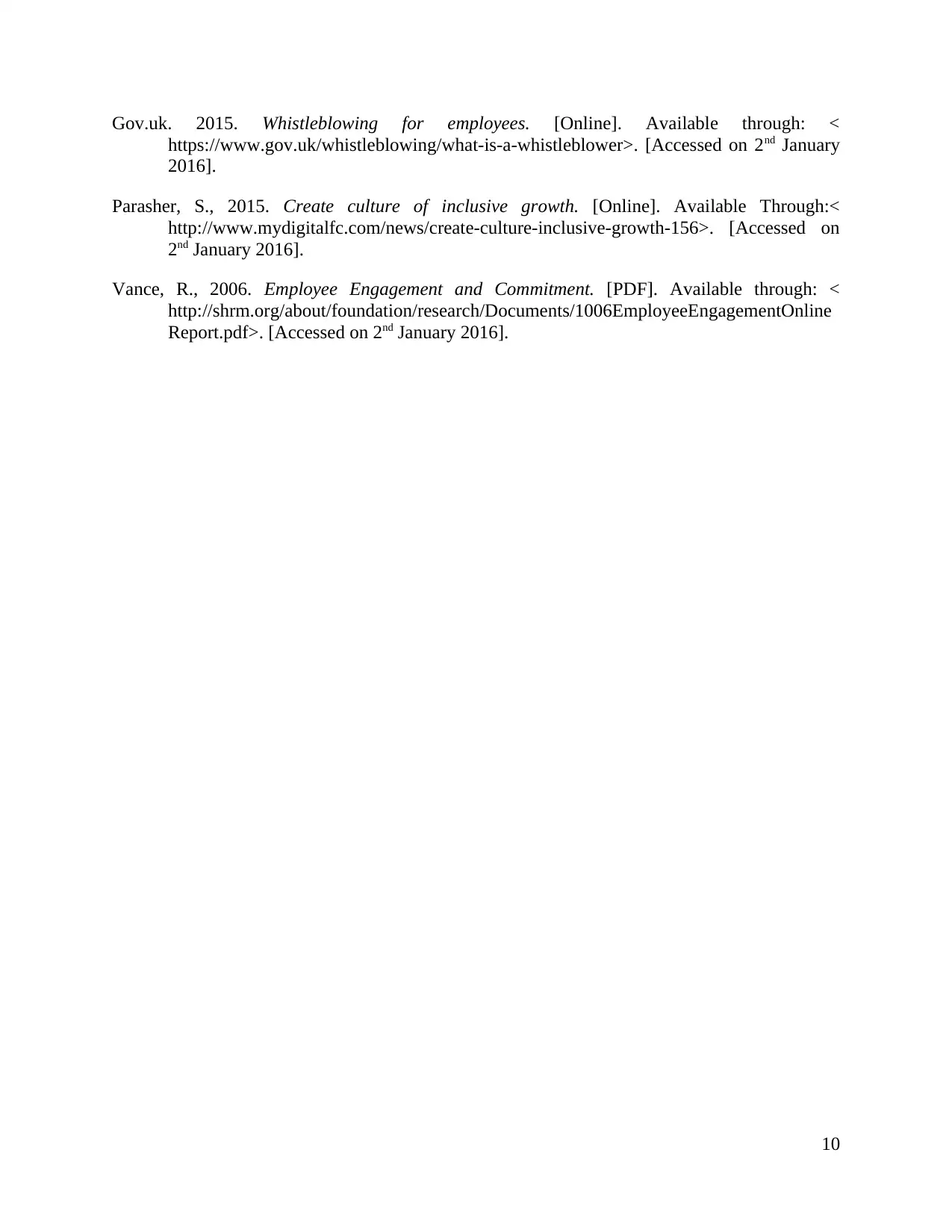
Gov.uk. 2015. Whistleblowing for employees. [Online]. Available through: <
https://www.gov.uk/whistleblowing/what-is-a-whistleblower>. [Accessed on 2nd January
2016].
Parasher, S., 2015. Create culture of inclusive growth. [Online]. Available Through:<
http://www.mydigitalfc.com/news/create-culture-inclusive-growth-156>. [Accessed on
2nd January 2016].
Vance, R., 2006. Employee Engagement and Commitment. [PDF]. Available through: <
http://shrm.org/about/foundation/research/Documents/1006EmployeeEngagementOnline
Report.pdf>. [Accessed on 2nd January 2016].
10
https://www.gov.uk/whistleblowing/what-is-a-whistleblower>. [Accessed on 2nd January
2016].
Parasher, S., 2015. Create culture of inclusive growth. [Online]. Available Through:<
http://www.mydigitalfc.com/news/create-culture-inclusive-growth-156>. [Accessed on
2nd January 2016].
Vance, R., 2006. Employee Engagement and Commitment. [PDF]. Available through: <
http://shrm.org/about/foundation/research/Documents/1006EmployeeEngagementOnline
Report.pdf>. [Accessed on 2nd January 2016].
10
⊘ This is a preview!⊘
Do you want full access?
Subscribe today to unlock all pages.

Trusted by 1+ million students worldwide
1 out of 12
Related Documents
Your All-in-One AI-Powered Toolkit for Academic Success.
+13062052269
info@desklib.com
Available 24*7 on WhatsApp / Email
![[object Object]](/_next/static/media/star-bottom.7253800d.svg)
Unlock your academic potential
Copyright © 2020–2025 A2Z Services. All Rights Reserved. Developed and managed by ZUCOL.





